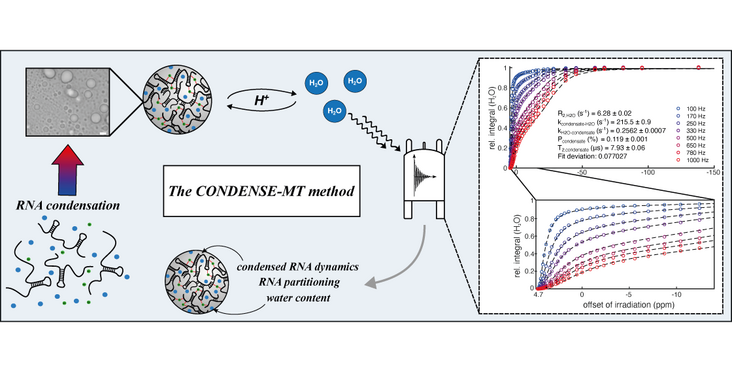This paper in “Nature Chemistry” by the Allain Group (IBC) presents an NMR method to characterize condensates formed by disease-associated CAG-repeat RNA. The method uses water-detection, revealing that such condensates are semi-solid and contain less water when increasing the number of CAG repeats.
Repeat-expansion disorders are relentless neurodegenerative disease, defined by pathologic expansions of genomic tri- or hexanucleotide repeat sequences. A hallmark of these disorders is the condensation of repeat-expansion RNA into nuclear RNA foci. While such RNA condensates can also be reconstituted in vitro, methods for their characterization remain sparse and, accordingly, their material properties are not understood.
Using NMR spectroscopy, researchers at IBC demonstrated that these condensates are entirely invisible in conventional liquid-state NMR spectra due to their gel-like, dynamically arrested viscoelastic properties. Exploiting this semi-solid material state, they devised a method to relay information about condensed RNA to the NMR-observable solvent water signal. This enabled detection and characterization of repeat-expansion RNA condensates in vitro by detecting only the solvent water NMR resonance.
The study demonstrates substantially reduced dynamics of RNA upon condensation, evidenced by 3-4 orders of magnitude decrease in molecular tumbling, compared to liquid-state RNA. Further, phase separation of RNA is driven by heterotypic interactions between RNA and Mg2+, which strongly affects partitioning of RNA into the condensates. Finally, applying this method revealed a substantial reduction in condensate hydration when increasing the number of trinucleotide-repeats, suggesting that RNA with more severe pathologic potential forms condensates with lower water content.
Read the Publication in Nature Chemistry (Open Access)
Figure from Schmoll, Novakovic and Allain (2025) Nature Chemistry published under a CC BY 4.0 license.
